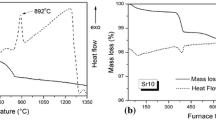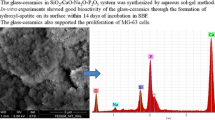Abstract
Sol–gel derived bioactive glasses are one of the most promising materials for bone regeneration. The nanostructure of the glasses is critical regarding their interaction with the physiological environment. Composition is one of the most important factors affecting the nanostructure. In this study, inhomogeneity (a translucent component surrounded by an opaque component) was found within sol–gel derived bioactive glass monoliths (70 mol% SiO2 and 30 mol% CaO) produced by a standard procedure. The nanostructure and composition of the two components were characterised by electron microscopy, nitrogen sorption, secondary ion mass spectroscopy, X-ray fluorescence and solid state nuclear magnetic resonance. Results showed that calcium concentration and nanoscale porosity were much higher in the opaque region than in the translucent component. This is believed to be caused by calcium nitrate accumulation on the outer surface of the monoliths during the drying stage of the sol–gel process. The homogeneity of monoliths was successfully improved by using Teflon moulds. These findings are important for the large scale commercial production of homogeneous sol–gel glasses.






Similar content being viewed by others
References
Hench LL, Splinter RJ, Allen WC, Greenlee TK (1971) Bonding mechanisms at the interface of ceramic prosthetic materials. J Biomed Mater Res Symp 2:117–141
Xynos ID, Adgar AJ, Buttery LDK, Hench LL, Polak JM (2001) Gene-expression profiling of human osteoblasts following treatment with the ionic products of Bioglass® 45S5 dissolution. J Biomed Mater Res 55:151–157
Sepulveda P, Jones JR, Hench LL (2001) Characterization of melt-derived 45S5 and sol–gel-derived 58S bioactive glasses. J Biomed Mater Res 58:734–740
Sepulveda P, Jones JR, Hench LL (2002) Bioactive sol–gel foams for tissue repair. J Biomed Mater Res 59:340–348
Jones JR, Ehrenfried LM, Hench LL (2006) Optimising bioactive glass scaffolds for bone tissue engineering. Biomaterials 27:964–973
Webster T, Ahn E (2007) In: Lee K, Kaplan DJ (eds) Nanostructured biomaterials for tissue engineering bone, in tissue engineering II. Springer, Berlin
Ohtsuki C, Kokubo T, Takatsuka K, Yamamuro T (1991) Compositional dependence of bioactivity of glasses in the system CaO–SiO2–P2O5: its in vitro evaluation. J Ceram Soc Jpn 99:1–6
Ohtsuki C, Kokubo T, Yamamuro T (1992) Mechanism of apatite formation on CaO–SiO2–P2O5 glasses in a simulated body fluid. J Non Cryst Solids 143:84–92
Saravanapavan P, Hench LL (2003) Mesoporous calcium silicate glasses. I. Synthesis. J Non Cryst Solids 318:1–13
Lin S, Ionescu C, Pike KJ, Smith ME, Jones JR (2009) Nanostructure evolution and calcium distribution in sol–gel derived bioactive glass. J Mater Chem 19:1276–1282
FitzGerald VF, Martin RM, Jones JR, Qiu D, Wetherall KM, Moss R, Newport RJ (2009) Bioactive glass sol–gel foam scaffolds: evolution of nanoporosity during processing and in situ monitoring of apatite layer formation using small and wide angle X-ray scattering. J Biomed Mater Res 91A:76–83
Zhong J, Greenspan DC (2000) Processing and properties of sol–gel bioactive glasses. J Biomed Mater Res 53:694–701
Brunaur S, Deming LS, Deming WS, Teller E (1940) On a theory of the Vander Waals adsorption of gases. J Am Chem Soc 62:1723–1732
Barrett EP, Joyner LG, Halenda PP (1951) The determination of pore volume and area distributions in porous substances. I. Computations from nitrogen isotherms. J Am Chem Soc 73:373–380
Sing KSW, Everett DH, Haul RAW, Moscou L, Pierotti RA, Rouquerol J, Siemieniewska T (1985) Reporting physisorption data for gas solid systems with special reference to the determination of surface-area and porosity (recommendations 1984). Pure Appl Chem 57:603–619
Saravanapavan P, Hench LL (2003) Mesoporous calcium silicate glasses. II. Textural characterisation. J Non Cryst Solids 318:14–26
Hench LL, West JK (1990) The sol–gel process. Chem Rev 90:33–72
El Rassy H, Pierre AC (2005) NMR and IR spectroscopy of silica aerogels with different hydrophobic characteristics. J Non Cryst Solids 351:1603–1610
Massiot D, Fayon F, Capron M, King I, Le Calvé S, Alonso B, Durand J, Bujoli B, Gan Z, Hoatson G (2002) Modelling one- and two-dimensional solid-state NMR spectra. Magn Reson Chem 40:70–76
Acknowledgments
NovaThera Ltd (NovaThera Ltd is a wholly owned subsidiary of MedCell BioSciences Ltd) is thanked for funding on the project and providing TheraGlass® particles. Julian R. Jones is a Royal Academy of Engineering EPSRC Research Fellow, and EPSRC are thanked for additional funding work on bioactive calcium silicates via projects EP/E057098 and EP/E051669. Richard Chater is thanked for his support with SIMS. MES thanks the University of Warwick, EPSRC, the Regional Development Agency (AWM) and the ERDF for partially funding the NMR infrastructure at Warwick. Sen Lin thanks the Society of the Chemical Industry (SCI) for a postgraduate scholarship.
Author information
Authors and Affiliations
Corresponding author
Rights and permissions
About this article
Cite this article
Lin, S., Ionescu, C., Baker, S. et al. Characterisation of the inhomogeneity of sol–gel-derived SiO2–CaO bioactive glass and a strategy for its improvement. J Sol-Gel Sci Technol 53, 255–262 (2010). https://doi.org/10.1007/s10971-009-2085-0
Received:
Accepted:
Published:
Issue Date:
DOI: https://doi.org/10.1007/s10971-009-2085-0




